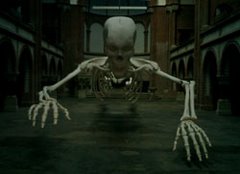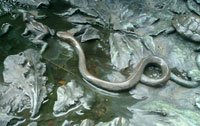 Kliwon, the giraffe was held captive in his pen for 13 years. Zoo visitors tossed plastic wrappers into its pen. The garbage accumulated and clogged the ruminating animal's digestive system. The living garbage bin collapsed in his stall and died. The plant eater had "a plastic lump weighing around 20 kilograms and 60 centimetres in diameter in his stomach".
Kliwon, the giraffe was held captive in his pen for 13 years. Zoo visitors tossed plastic wrappers into its pen. The garbage accumulated and clogged the ruminating animal's digestive system. The living garbage bin collapsed in his stall and died. The plant eater had "a plastic lump weighing around 20 kilograms and 60 centimetres in diameter in his stomach".The home ranges of the tallest living terrestrial animal are usually open woodlands and savannas where it eats plant-based food. Humans have long exploited body parts of the animal and encroached on its habitat. Human settlements and their livestock are pushing the creature out of existence.
The Romans first imported and exhibited the animal as a spectacle as part of their 'Bread and Circuses' for the people. White big game hunters enjoyed the 'sport" of competitive killing in colonial Africa. Even today, recreational killing of the few giraffes left in hunting safaris is enjoyed by families.

Showcasing and selling wild animals in overpopulated zoos is profitable. In Kliwon's Surabaya Zoo "500 animals had died between 2010 and 2011." The zoo workers’ cooperative runs the stalls that cater to the customers food plus plastic wrapper needs.
A zoo visit is supposed to be 'taking the kids out and fun for the family'. A getting away from a lackluster everyday life and being animated by a menagerie of exotic animals that are held captive all at once at one's command. It offers "amusement without demanding exertion." Parents welcome outsourcing the service of interaction to other creatures. Distraction gives them a break.
Kids gape in wonder at the captive creatures. Junk food offering, rattling cages or banging on glass walls often enhances the 'performance' of the caged being that has no means of escaping. Safe and in control one can learn to initiate a one sided 'interaction'.
 In this asymmetrical relationship the wildlife spectators learn the animal/human dichotomy and experience themselves as free "Peeping Toms". The powerlessness of the powerful mega fauna instills strength in the 'king of beasts', the Homo sapiens. One can stroll through the zoos or aquariums, theme parks, marine mammal parks, oceanarium, etc and eat some plastic wrapped fish/meat, engage in petting or just stare at the homeless curiosities.The hunger for sensations and distractions is good business. The peep industry in all of its forms profits. For many animals it is the last and only habitat on planet Earth allocated by humanity.
In this asymmetrical relationship the wildlife spectators learn the animal/human dichotomy and experience themselves as free "Peeping Toms". The powerlessness of the powerful mega fauna instills strength in the 'king of beasts', the Homo sapiens. One can stroll through the zoos or aquariums, theme parks, marine mammal parks, oceanarium, etc and eat some plastic wrapped fish/meat, engage in petting or just stare at the homeless curiosities.The hunger for sensations and distractions is good business. The peep industry in all of its forms profits. For many animals it is the last and only habitat on planet Earth allocated by humanity.
Soon there will be no remaining 'wildlife' untagged not on a 24/7 web cam and all shall only exist as part of our panopticon.
Images:
Head of a giraffe, Meyers Großes Konversations-Lexikon
Weigel, Hans: Giraffe, Wonder animal
Macke, August: Großer Zoologischer Garten, Triptychon 1913
Giraffe, bending for food. Brehm, Alfred/Brehms Thierleben
Updates
Conservationists warn of giraffe extinction, Human encroachment on giraffe habitat is seen as the biggest threat. 10.13
Zoo kills healthy giraffe in front of minors and feeds meat to lions, Guardian 02.2014
Disposable captives, Lori Gruen, 10.04.2014
There are about 80,000 giraffes left in the wild. The land is used for agriculture: habitat loss and fragmentation abc 04122014








No comments:
Post a Comment